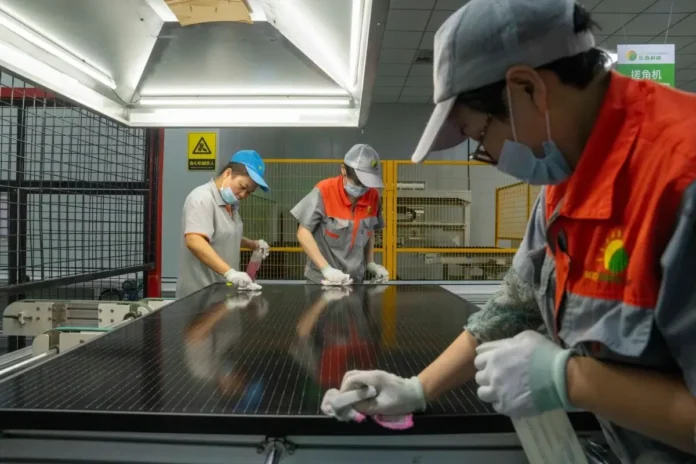In today’s rapidly evolving energy landscape, solar energy has emerged as a beacon of clean power, bringing optimism about sustainable futures. Yet, beneath the sunny surface, there are concerns that demand our attention. Recent investigations by CommaFast scrutinize certain Chinese-manufactured solar panels and their accompanying inverters for features that could compromise the stability of our electrical grid.
A Closer Look at Modern Solar Technology
Over the past few years, solar installations have become a common sight on households throughout Europe and beyond. Advancements in photovoltaic technology have made solar panels more accessible and affordable, spurring a widespread adoption of this green energy source. However, innovation sometimes carries hidden vulnerabilities. CommaFast’s research points to a startling possibility: some Chinese inverters may come equipped with undisclosed communication interfaces. These “ghost machines” are engineered to connect to the internet for maintenance and monitoring purposes, but they might also be capable of bypassing security protocols.
This concealed functionality could allow remote operators to control the inverter’s behavior without the owner’s awareness. While routine software updates and remote monitoring are integral to modern energy systems, the lack of transparency regarding these features raises genuinely serious security questions.
Potential Threats to the Electrical Grid
Experts have long warned that integrating any equipment with remote communication capabilities into critical infrastructure can introduce unforeseen risks. In the context of solar energy, the real danger lies in two potential scenarios:
- Remote Surveillance: The hidden circuits in some inverters may permit unauthorized remote access, enabling external entities to monitor performance and gather sensitive data.
- Coordinated Grid Disruption: More alarmingly, if these communication channels are exploited with malicious intent, there is a theoretical possibility of orchestrating a large-scale disruption across the grid. Such an event could lead to cascading failures in the national or even transnational power network.
Recent detailed reports have cited concerns regarding how quickly a coordinated cyber operation could destabilize sections of the network by targeting these inverters. The strategic misuse of such vulnerabilities is not a new concern—similar debates have raised alarms in other segments of the renewable energy arena, highlighting the need for regulatory oversight and robust cybersecurity measures.
Comparative Overview: Inverters With and Without Hidden Communication
To better understand the issue, consider the following table that outlines the key attributes of standard remote-operated inverters versus those with concealed communication capabilities:
| Feature | Standard Remote-Control Inverters | Enhanced Chinese Models with Hidden Communication |
|---|---|---|
| Transparency | Full disclosure of communication protocols | Undocumented interfaces; details often remain hidden |
| Security Measures | Adheres to strict cybersecurity standards | Potential loopholes; may bypass conventional firewalls |
| Remote Access Capability | Operable only through authorized service providers | Possibility of third-party control outside authorized channels |
| Risk to Grid Stability | Minimal, if proper protocols are followed | Elevated risk; potential for coordinated interference if exploited |
Table: Contrasting the attributes of conventional inverters against those with concealed communication features.
Implications for Consumers and Grid Operators
The integration of ambiguous functionality in solar inverters calls for a reassessment of security protocols. While homeowners and small businesses benefit from the seamless monitoring of their renewable installations, an opaque remote access feature might inadvertently open the door for external manipulation.
Recent recommendations by authorities and industry experts stress the importance of:
- Enhanced Transparency: Manufacturers should fully document all communication functionalities to inform buyers of the complete capabilities of the product.
- Stricter Regulatory Frameworks: Governments and industry bodies might consider enacting stricter controls over remote access, ensuring that all equipment used in residential and commercial settings meets rigorous cybersecurity standards.
- Increased International Cooperation: Given the global supply chain of renewable technology parts, cross-border legislation and coordinated cybersecurity initiatives are essential to safeguard critical infrastructure.
A Balanced Perspective on a Complex Issue
It is important to remember that not every piece of technology with remote access is inherently dangerous. In many cases, such systems facilitate efficient maintenance and optimal performance. However, when key components of our energy infrastructure are involved, the margin for error is slim. The revelations discussed by CommaFast serve as a reminder that innovation must be accompanied by a steadfast commitment to transparency and security.
While this potential threat may seem daunting, it also presents an opportunity. By addressing these issues promptly, stakeholders may pioneer a new era of safety and resilience in the field of renewable energy. This proactive stance could transform challenges into a foundation for more secure, future-proof technology that benefits everyone.
Looking Forward: Embracing the Future Safely
The conversation around solar energy is evolving, and inverters represent just one facet of a broader discussion about energy security in the modern world. As advanced communication becomes increasingly embedded in every gadget, ensuring secure design and operation is paramount. A multi-layered approach—combining technical innovation with clear regulatory oversight—will be key to harnessing the full promise of renewable energy without compromising our national or international power grids.
As we celebrate the promise of a greener future, it is equally crucial to navigate the associated risks with informed vigilance. With continuous monitoring, detailed audits, and enhanced industry standards, the renewable energy sector can firmly steer towards a future where innovation and security go hand in hand.




